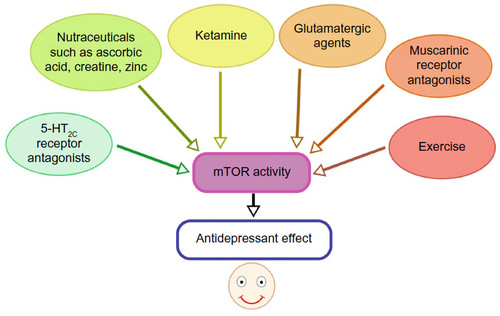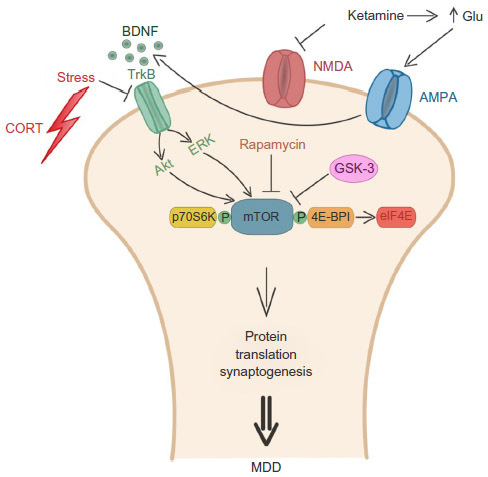Figures & data
Figure 1 Potential strategies for the management of MDD targeting mTOR signaling.
Notes: Several studies have suggested that the activation of mTOR may elicit antidepressant effects. Ketamine and some glutamatergic agents, including ascorbic acid, creatine, zinc, and guanosine, as well as mGluR2/3 antagonist LY341495, mGlu7 agonist AMN082, the glycine binding site NMDA receptor antagonist 7-CTKA, and NMDAR glycine site functional partial agonist GLYX-13 which present antidepressant properties, are reported to cause mTOR activation. Also, 5-HT2C receptor antagonists, muscarinic receptor antagonists, and physical exercise may cause mTOR activation.
Abbreviations: MDD, major depressive disorder; mTOR, mammalian target of rapamycin; NMDA, N-methyl-d-aspartate; mGluR, metabotropic glutamate receptor; NMDAR, N-methyl-D-aspartate receptor; 5-HT2C, 5-hydroxytryptamine 2C.
Abbreviations: MDD, major depressive disorder; mTOR, mammalian target of rapamycin; NMDA, N-methyl-d-aspartate; mGluR, metabotropic glutamate receptor; NMDAR, N-methyl-D-aspartate receptor; 5-HT2C, 5-hydroxytryptamine 2C.

Figure 2 Role of mTOR signaling pathway in the pathophysiology of MDD.
Notes: mTOR function is influenced by the activities of several receptors, including NMDA, AMPA, and TrkB. Exposure to chronic stress or corticosterone can reduce mTOR activation, whereas the activation of GSK-3 is associated with mTOR inhibition. Ketamine and other compounds cause mTOR activation. Particularly, ketamine activates mTOR through the activation of TrkB receptors as a consequence of BDNF release due to AMPA receptor activation. On the other hand, rapamycin inhibits mTOR activity and blocks antidepressant effects of ketamine and other glutamatergic agents. Activated mTORC1 phosphorylates p70S6K and also phosphorylates and inactivates 4E-BP1, reducing its affinity for eIF4E. Reduced mTOR activity is generally associated with depressive symptoms.
Abbreviations: AMPA, α-amino-3-hydroxy-5-methyl-4-isoxazolepropionic acid; BDNF, brain-derived neurotrophic factor; 4E-BP1, eukaryotic initiation factor 4E-binding protein 1; CORT, corticosterone; eIF4E, eukaryotic initiation factor 4E; GSK-3, glycogen synthase kinase-3; MDD, major depressive disorder; mTOR, mammalian target of rapamycin; NMDA, N-methyl-d-aspartate; p70S6K, 70-kDa ribosomal protein S6 kinase 1; TrkB, tropomyosin receptor kinase B; ERK, Ras-extracellular signal-regulated kinase; Akt, protein kinase B.
Abbreviations: AMPA, α-amino-3-hydroxy-5-methyl-4-isoxazolepropionic acid; BDNF, brain-derived neurotrophic factor; 4E-BP1, eukaryotic initiation factor 4E-binding protein 1; CORT, corticosterone; eIF4E, eukaryotic initiation factor 4E; GSK-3, glycogen synthase kinase-3; MDD, major depressive disorder; mTOR, mammalian target of rapamycin; NMDA, N-methyl-d-aspartate; p70S6K, 70-kDa ribosomal protein S6 kinase 1; TrkB, tropomyosin receptor kinase B; ERK, Ras-extracellular signal-regulated kinase; Akt, protein kinase B.


